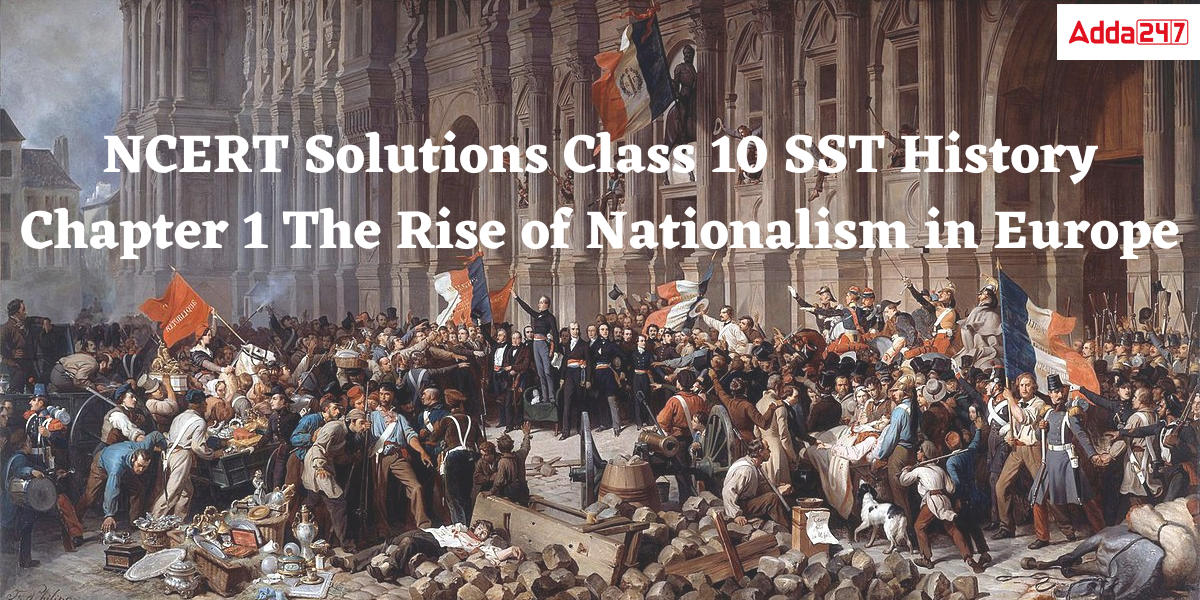Table of Contents
History Class 10 Chapter 1 Question Answer
NCERT Solutions history class 10 chapter 1 question answer Rise of Nationalism in Europe notes are given in this article. NCERT Solutions Class 10 is the best resource for obtaining a good score in the class 10 board Examination. Here are Adda247 Expert faculty team prepared NCERT Solutions Class 10 SST History Chapter 1 Rise of Nationalism in Europe exercises of that chapter for a better grasp of the topics. These NCERT Solutions answer all questions in an easy and simple manner. These solutions will help you understand the concepts covered in the chapter completely. By writing these answers in the exam students will undoubtedly be able to achieve high scores. Keep learning with Adda247.
Read: NCERT Solutions for Class 10 SST History Chapter Chapter 2 Nationalism in India
NCERT Solutions Class 10 SST History Chapter 1 Rise of Nationalism in Europe Pdf Download
NCERT Solutions Class 10 SST History Chapter 1 Rise of Nationalism in Europe pdf is given in pdf format so students can easily download it for future use. Click here to download
NCERT Solutions Class 10 SST History Chapter 1 Rise of Nationalism in Europe
NCERT Solutions Class 10 SST History Chapter 1 The Rise of Nationalism in Europe Topics
Class 10 SST History Chapter 1 Rise of Nationalism highlights a number of events that started with the Nations in 1848. Nationalism became a powerful force in the nineteenth century, changing Europe’s political and psychological environment dramatically. In place of the multi-nation dynastic empires of Europe, these shifts ultimately led to the rise of the nation-state. Before going to the NCERT Solutions Class 10 SST History Chapter 1 Rise of Nationalism in Europe, Let’s take a quick tour of the topics and subtopics which are included in the Class 10 SST History Chapter 1 Rise of Nationalism in Europe
- The French Revolution and the Idea of the Nation
- The Making of Nationalism in Europe
- The Aristocracy and the New Middle Class
- What did Liberal Nationalism Stand for?
- A New Conservatism after 1815
- The Revolutionaries
- The Age of Revolutions: 1830-1848
- The Romantic Imagination and National Feeling
- Hunger, Hardship and Popular Revolt
- 1848: The Revolution of the Liberals
- The Making of Germany and Italy
- Germany – Can the Army be the Architect of a Nation?
- Italy Unified
- The Strange Case of Britain
- Visualising the Nation
- Nationalism and Imperialism
History Chapter 1 Nationalism in Europe Class 10 Questions and Answers
1. Write a note on:
a) Guiseppe Mazzini
b) Count Camillo de Cavour
c) The Greek war of independence
d) Frankfurt parliament
e) The role of women in nationalist struggles
Answer:
a) Guiseppe Mazzini – Italian national Giuseppe Mazzini was born in Genoa in 1807. . Giuseppe Mazzini had worked to develop a cogent plan for the united Italian Republic during the 1830s. In order to further his objectives, he also founded a secret organisation named “Young Italy.”
b) Count Camillo de Cavour-
- He was the chief minister of Sardinia-Piedmont state. He was the leader of the Italian regional unification movement. \
- He committed his life to free northern Italy from Austrian rule. He was a brilliant and tenacious diplomat who was instrumental in the unification of Italy.
- In 1859, Sardinia-Piedmont was successful in defeating the Austrian army thanks to tactful diplomatic alliance that Cavour skillfully constructed.
c) The Greek war of independence
- The Greek War of Independence, also referred to as the Greek Revolution was fought by Greeks from the years 1821 to 1829 in order to secede from the Ottoman Empire.
- Greece had been a part of the Ottoman Empire since the fifteenth century. The Greek independence war started in 1821 as a result of the rise of revolutionary nationalism in Europe.
- Greek nationalists received backing from fellow exiled Greeks as well as many West Europeans who supported ancient Greek culture.
- The Treaty of Constantinople, which was signed in 1832, officially recognized Greece’s independence.
d) Frankfurt parliament –
- The Frankfurt Parliament was the first democratic elected assembly for all of Germany, including Austria-German-speaking Hungary’s regions.
- It was an all-German national assembly made up of professionals from the middle class, entrepreneurs, and wealthy artisans from various German regions.
- The liberal movement that swept the German states at the beginning of 1848 led to the formation of the Frankfurt Parliament (1848–49), which met in Frankfurt on May 18, 1848.
- The first meeting of Frankfurt Parliament was held on May 18, 1848, in the Church of St. Paul in Frankfurt, where 831 elected representatives marched in a joyful procession to assume their seats. They created a constitution for German that would be ruled by a monarchy and be governed by a parliament.
e) The role of women in nationalist struggles
- Women established political organizations, started publications, and participated in political rallies and protests.
- Women joined the Frankfurt Parliament as observers even though they were not permitted to cast Votes.
- The liberal movements also attracted a sizable number of female participants.
2. What steps did the French revolutionaries take to create a sense of collective identity among the French people?
The following steps are taken by French revolutionaries to create a sense of collective identity among the French people :
- The French revolutionaries developed a number of policies and practices that could help the French people develop a feeling of national identity. The concepts of “La Patrie” and “Le Citoyen” emphasized the idea of a single society with equal rights protected by a constitution.
- The previous royal standard was changed to the new French flag, the tricolour.
- A group of people that were elected to this National Assembly was formerly known as the Estate General.
- A centralized administrative structure was established, and all of the residents of its territory were subject to the same set of rules.
- A consistent system of weights and measurements was introduced, and internal customs charges and fees were eliminated.
3. Who were Marianne and Germania? What was the importance of the way in which they were portrayed?
Answer: Germania and Marianne were feminine allegories for the German and French countries, respectively. The popular Christian name Marianne highlighted the concept of a people’s nation.On the other hand, Germania came to represent the German people. Germania is shown wearing an oak leaf crown because the German oak is a symbol of valour.
The significance of how they were portrayed is as follows:
- The notion of a nation was represented by female characters who aimed to give it a physical form.
- The woman picked to represent the country did not represent any one woman in real life.
- They fought for concepts like “liberty” and “the republic.”
4. Briefly trace the process of German unification.
Answer: The German middle class attempted to create a nation-state with an elected parliament in 1848 by bringing together several German confederation districts. They are suppressed by the military and monarchy working together to win Prussia’s allegiance. Due to the acts of powerful landowners known as the Prussian Junkers, middle-class German plans did not materialize. Prussia prevailed in three conflicts spanning seven years with Austria, Denmark, and France.
5. What changes did Napoleon introduce to make the administrative system more efficient in the territories ruled by him?
Napoleon performed the following changes to make the administrative system more efficient in the areas ruled by him:
- In 1804 he introduced the Napoleonic Code, often known as the civil code. All birth-based privileges were abolished. It guaranteed the right to property and established equality before the law.
- In the Netherlands, Switzerland, Italy, and Germany, Napoleon simplified administrative divisions.
- Peasants were released from serfdom and manorial duties after the feudal system was abolished.
- The guild limitations were also lifted in the towns.
- Systems for transportation and communication were enhanced.
- The newly found freedom was enjoyed by farmers, craftspeople, labourers, and new business owners.
6. Explain what is meant by the 1848 revolution of the liberals. What were the political, social, and economic ideas supported by the liberals?
Answer: During the 1848 Revolution, the 1848 revolution of liberals described the national movements as being supported by the educated middle class and opposed by the unemployed, underprivileged, and famished workers of Europe. Men and women of the liberal middle classes banded together to promote their demands for the establishment of nation-states founded on parliamentary principles in some regions of Europe, including Germany, Italy, Poland, and the Austro-Hungarian Empire.
The political, social, and economic ideas supported by the liberals are:
- Socially, They aimed to eliminate birthright and class-based prejudices from society. It was necessary to eradicate bonded labour and serfdom.
- Politically, a constitution is demanded along with the union of nationalism, a constitution, and parliamentary governance.
- Economically, They desired property rights and market freedom from an economic perspective. elimination of barriers placed by the government on the flow of capital and goods.
2. Choose three examples to show the contribution of culture to the growth of nationalism in Europe.
Answer: Three examples that show the contribution of culture to the growth of nationalism in Europe are:
- Folk music, poetry, and dances were crucial in spreading nationalism throughout Europe. preserving and gathering various folk traditions in order to foster national consciousness. To reach a wide range of audiences, common people used to spread nationalist messages.
- Romanticism: A certain brand of nationalism was to be developed through the romanticism cultural movement. In an effort to build a sense of a shared collective legacy, a common cultural past, as the foundation of a nation, romantic artists and poets concentrated on emotions, intuition, and mystical experiences.
- Language: An major factor in the emergence of nationalist feelings was language. After the Russian invasion, the Polish language was outlawed and replaced everywhere with Russian. In Poland, the clergy started utilising language as a tool of anti-nationalist struggle. In Poland, the clergy started utilising language as a tool of anti-nationalist struggle. Church gatherings and all religious instruction were conducted in Polish. Polish usage eventually came to be viewed as a symbol of resistance to Russian control. Church gatherings and all religious instruction were conducted in Polish. Polish usage eventually came to be viewed as a symbol of resistance to Russian control.
3. Through a focus on any two countries, explain how nations developed over the nineteenth
Answer: The rise of nation-states in Germany and Italy in the nineteenth century.
- Since there were several widespread revolutions across Europe. In 1848, the middle class of various German areas banded together to create the German National Assembly.
- Mazzini tried to bring Italy together in the 1830s. Young Italy, a covert organisation he founded, was a failure. As a result, it was King Victor Emmanuel II of Sardinia-responsibility Piedmont to unite Italian states through war.
- The army and aristocracy united Germany and Italy when the revolution failed. In 1871, German was established. Otto von Bismark united Germany with the help of the Prussian government and military.
4. How was the history of nationalism in Britain unlike the rest of Europe?
Answer: The history of nationalism in Britain is unlike the rest of Europe because:
- People who lived in the British Isles were mostly identified by their ethnicities, such as English, Welsh, Scots, or Irish.
- The creation of the nation-state in Britain did not occur as a result of an abrupt upheaval or revolution. It was the end consequence of a protracted procedure.
- Since Scotland and England joined to form the “United Kingdom of Great Britain” in 1707, England will now exert influence on Scotland. Scotland’s political institutions and culture were suppressed.
- The previous countries only remained as subordinate partners in this union, with the Union Jack serving as the national flag, God Save Our Noble King as the national anthem, and English as the official language.
5. Why did nationalist tensions emerge in the Balkans?
Answer: The Balkan region became the main cause of nationalist tension in Europe after 1871. The modern-day nations of Albania, Greece, Romania, Bulgaria, Macedonia, Croatia, Bosnia, Slovenia, Serbia, Herzegovina, and Montenegro are all included in the historical Balkans, a region with many different ethnic groups. Due to the development of romantic nationalism ideologies and the collapse of the Ottoman Empire, which had previously ruled over this region, nationalist tensions erupted in the Balkans. The many Slavic ethnic groups in the Balkans started to push for independence. The Ottoman Empire attempted to strengthen itself throughout the nineteenth century through modernization and internal reforms, but with very little success.
The Balkan peoples built their claims for independence or political rights on nationality and utilised history to demonstrate that they were previously independent but had since been oppressed by foreign powers. Since their struggles were aimed at regaining their long-lost independence, the Balkans’ rebellious nationalities saw them as such.


 Indigo Class 12 Questions and Answers fo...
Indigo Class 12 Questions and Answers fo...















Hello! Do you use Twitter? I’d like to follow you if that would be
okay. I’m absolutely enjoying your blog and look forward
to new posts.